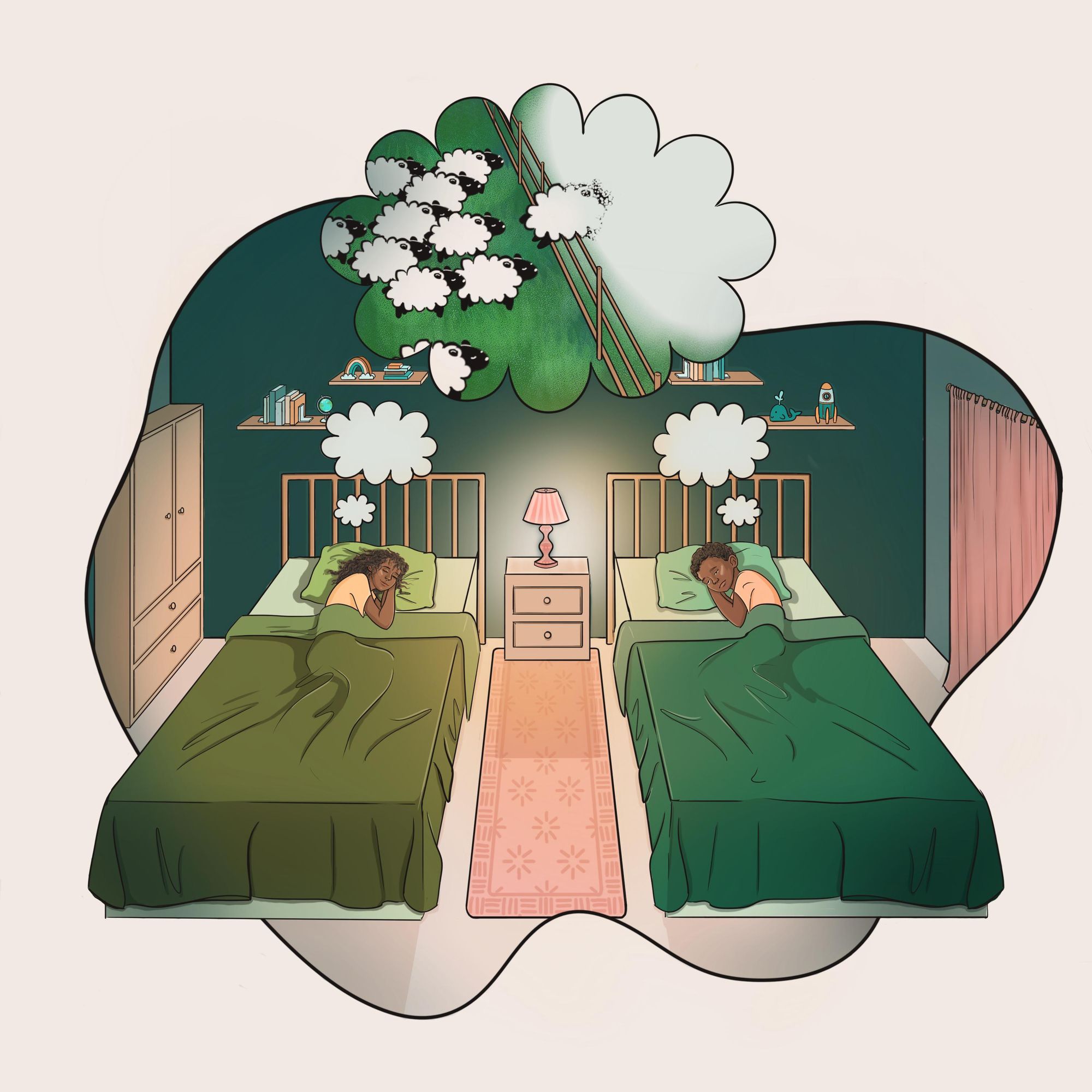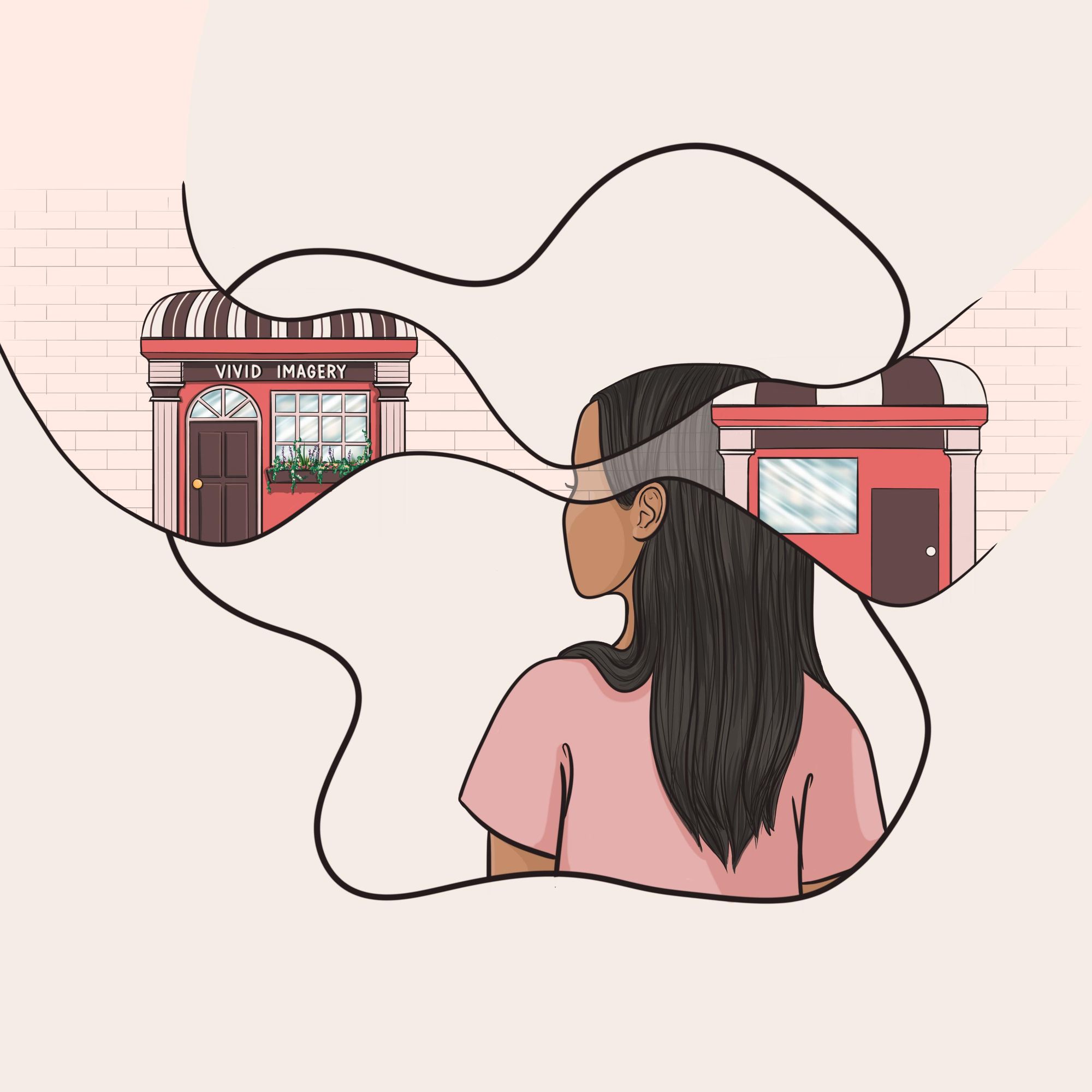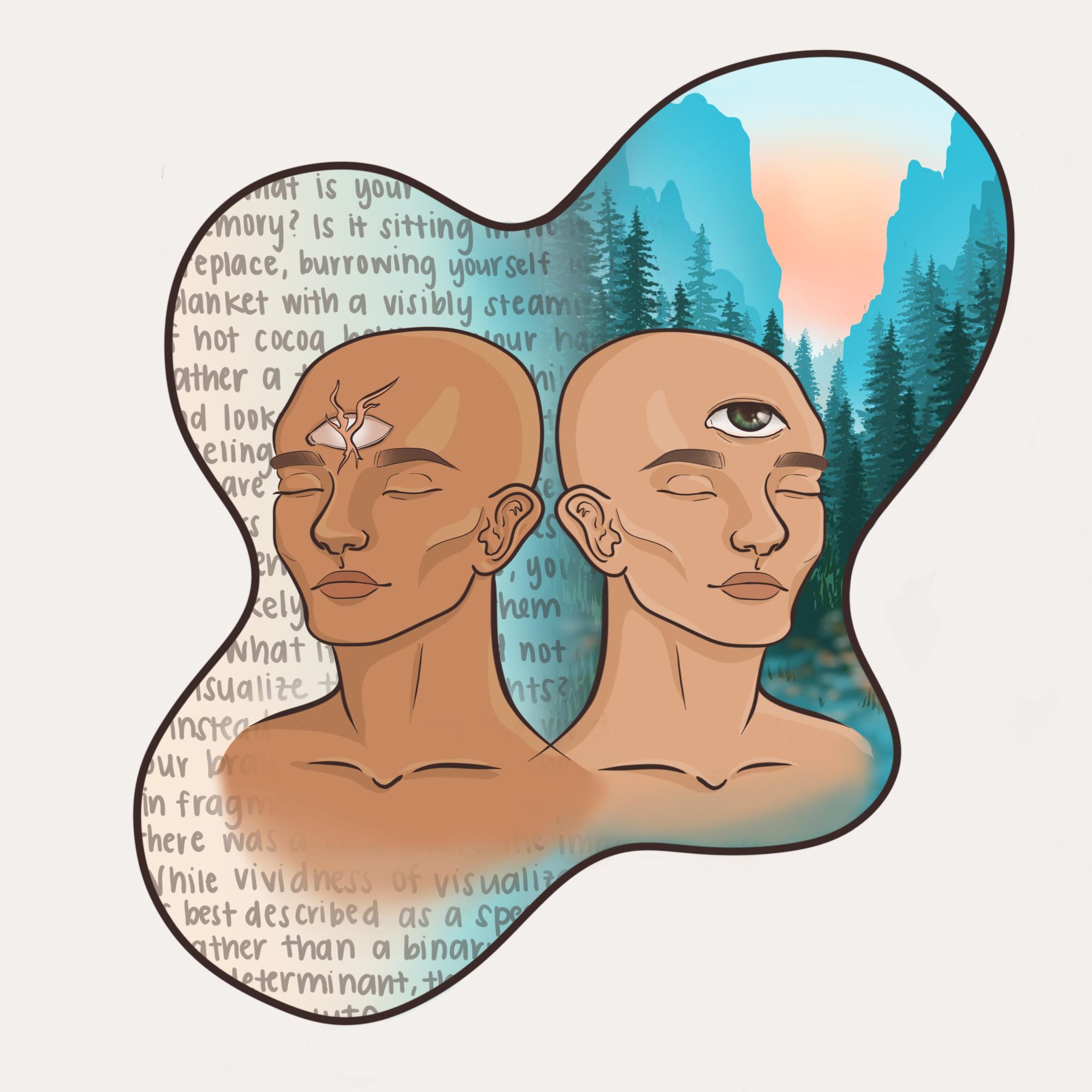Introduction
What is your favorite memory? Is it sitting in front of the fireplace, burrowing yourself under a blanket with a visibly steaming cup of hot cocoa between your hands? Or is it a time you went hiking and stood atop a mountain with a feeling of achievement as you stared down at the tiny houses and cars below? Whatever these memories may be, you most likely remember them vividly. But what if you could only see broken fragments, or even more severely, not actually visualize these moments at all? While vividness of visualization exists on a spectrum rather than a binary, the absolute absence of any ability to visualize has a diagnosable name: aphantasia. It is estimated that roughly 2% of the world’s population may have this condition, many of whom are unaware that they do [1]. In fact, it is common for people affected by aphantasia to be well into their teens before they realize that people are not being figurative when they say they can “imagine an image”.
People with aphantasia often cannot explain how they visualize their thoughts, as they do not create mental images in the first place. Because of this, the condition of aphantasia serves as a gateway to the realm of metacognition, otherwise known as “thinking about your thinking”. Suddenly this becomes a great opportunity to explore the question: what happens when a person lacks metacognition? While metacognitive insight drops, recollection abilities are not always significantly impacted by aphantasia, as we will observe throughout this article. Individuals with aphantasia or low visualization abilities have provided a means for scientists to unveil unconscious mental imaging processes.
Biological Basis of Mental Imagery
To understand the implications of metacognition in aphantasia, we need to understand the basic neurological processes of vision and its interactions throughout the brain. Knowing these processes will allow us to have a basic understanding of mental imagery formation and therefore, the cause of aphantasia. The process of visual perception starts with light entering your pupil. The photoreceptors, which are cells lining the back of your retina, convert the light into electric pulses that are transmitted through the optic nerve directly behind the eye. The nerve is composed of multiple cellular axons that pass on electrical signals, also known as action potentials, between various structures (unnamed for the sake of simplicity) that direct the action potential to the primary visual cortex in the occipital lobe at the back of your brain. The different areas of the visual cortex help determine the raw perception of what you are seeing based on the group of signals received.
In addition to the signals sent from your retina to the primary visual cortex, these signals are relayed to other areas of your brain that help you associate meanings and memories. Signals sent to areas of the temporal lobe, located in the lower midsection of your brain, allow you to associate names and faces with the identities of people you see [2]. The parietal lobe, which is in the upper back area of your brain, assists in determining how far an object is relative to another object. It also creates your visual working memory so that you can remember visual information over a short period of time [3]. Sections of the frontal lobe, located in the anterior of your brain, may control voluntary concentration while visualizing [4]. Although the exact functions are not widely understood, it is these lobes working together (visual, temporal, parietal, and frontal) that enable us to mentally visualize, otherwise known as seeing through our “mind’s eye”. With these biological connections in mind, what happens when the mind’s eye is blocked by aphantasia?

Study #1: Determining Abilities of an Aphantasic Individual
Despite a lack of awareness of any mental imagery, an aphantasic individual still likely possesses some unknown ability to visualize mentally. In a study done at the University of Westminster in 2018 by Drs. Christianne Jacobs, Dietrich S. Schwarzkopf, and Juha Silvanto, an aphantasic individual (API) was presented with a screen that had a shape in the center that quickly disappeared [5]. A dot was then shown randomly on the screen and the API had to identify whether the dot was inside the bounds of the shape. In theory, this task requires a mental image to recall the shape and relate it to the location of the dot. However, the API was able to identify the dot’s location relative to the shape just as well as individuals without aphantasia for low to medium difficulty levels of the same task. The API had a minimal understanding of how she determined her answers with such precision without being able to form a mental image [5]. This led to a new question: how could the API accomplish this task without the ability to visualize? Perhaps she developed an alternative method of relating the locations of the shape and the dot that does not require mental imagery. This suggests the idea that the absence of visual imagery vividness entails a lack of metacognition, but not lack of ability.
While we are getting a grasp of functional ability within aphantasia, the difference in brain activity of people with aphantasia versus those without remains unknown. Unfortunately, gathering large groups of aphantasic individuals has proven difficult, so researchers have gathered data from groups of people similar to APIs to answer this question. Since vividness of mental visualization exists on a spectrum, we can explore the brain activity of people with low vividness to extrapolate the unconscious biological pathways in the most extreme case of aphantasia.
Study #2: Investigating the Neurobiology of Vividness
While people with low vividness of mental imagery do not consciously imagine the same level of detail as others, it does not necessarily mean that those cognitive processes involved in mental imagery are absent. In the same year, 180 miles west of where the first study took place, 111 students at the University of Exeter Medical School were separated into groups of low-vividness of visual imagery (LV) and high-vividness of visual imagery (HV). Drs. Jon Fulford, Fraser Milton, and Adam Zeman based these groupings on their answers to a Vividness of Visual Imagery Questionnaire [6]. This questionnaire assesses an individual’s ability to picture a scene described to them in words with questions like, “Can you picture the front of a grocery store?” followed by prompts to imagine consecutively more complicated details such as, “Can you imagine flowers planted next to the door?”. Participants then scored their ability to imagine the subject of each question on a scale of 1-5, with 5 indicating they can easily visualize the scene. LV participants (average score of 3.11) were characterized as only being able to see main details, such as a store, but not being able to see smaller details such as the frame of the door, flowers growing at the front, or exchanging money with the cashier. HV participants (average score of 4.05) had little to no trouble visualizing these small details. Both groups were then tested for brain activity during imagery tests by presenting words that they were instructed to visualize. All this was done as the participants were laying down in a functional magnetic resonance imaging machine (fMRI). This records levels of blood flow corresponding to that region’s energy usage, acting as an indirect measurement of brain activity in that area.
The results of the study demonstrated that the areas activated remained similar between the two groups, but LV participants had higher brain activity in areas across the brain previously correlated to mental imagery and imagination than those who visualized clearly [6]. While this is far from a comprehensive list of all their findings, we will investigate a couple of these areas to find a very rough possible explanation. One of these areas with higher activation was found in the frontal lobe. This area, the middle frontal gyrus, likely redirects endogenous (voluntary) attention to exogenous (involuntary) attention [4]. In other words, the middle frontal gyrus interrupts intentional focus with unintentional focus, similar to when you are distracted by a sudden noise. This could imply that the middle frontal gyrus is preventing active awareness of visual processing and mental imagery in LV participants. Another area that showed higher activation in LV participants was the middle temporal gyrus, which plays a role in semantic memory processing [7]. Semantic memory is conceptual or factual knowledge such as dates or names, and as such is not normally associated with visualization. However, using this as an unconscious alternate pathway for visual working memory in LV participants could explain the unexpected shape and dot location abilities of the API in the first study.
It is important to recognize that the ideas of the following two paragraphs are my own hypotheses and not from the authors of the studies. Rather, these sections serve as a way for us to explore and apply our own critical thinking.

Hypothesizing a Neurobiological Basis for Spatial Working Memory
The discovery that LV individuals have higher brain activity in the supramarginal gyrus and middle temporal gyrus could lead us towards the cause of low awareness of mental imagery. Knowing that the middle frontal gyrus may prevent active awareness, its strong activation in LV participants could explain why they lack metacognition. This alternate neural pathway could include the middle temporal gyrus as a method of storing visual information outside of normal visual working memory. We have now established a possible neurological basis for low vividness mental image processing by combining the findings of these studies. With these limitations in mental imagery among LV individuals, we could expect that similar but more intense effects will be present in people with aphantasia, who have absolutely no vividness.
Extrapolating Neural Mechanisms of Aphantasia
Both of these studies had participants who had difficulty visualizing and were unable to identify how their brains compensated for this ability where most people would just say that they imagined the complete shape or picture in the corresponding task. Once again, these are instances where there is a lack of metacognition. The first study done by Drs. Jacobs, Schwarzkopf, and Silvanto reveal that an aphantasic participant was able to accomplish some degree of visualization even if they could not qualitatively explain how. The second study done by Drs. Fulford, Milton, and Zeman have fMRIs of LV participants that show two sections of the brain which could clarify this anomaly in aphantasic individuals. The middle frontal gyrus could explain the suppression of awareness in attempting to visualize while the middle temporal gyrus provides a possible method of retaining visual information without visual working memory. While this idea is purely speculative and would require much further testing to confirm, such possibilities serve as a reminder of how little we know about human cognition.
Conclusion
This peculiar condition offers an incredible opportunity to study important phenomena including metacognition and our precious mind’s eye. Furthermore, understanding the underlying processes of aphantasia can open a wide range of possibilities for future research in subjects such as memory and learning. Unfortunately, this task is difficult to accomplish with the lack of affected individuals’ ability to explain their thought processes and relative lack of recent scientific research on aphantasia. Although inferences can be made, the cognitive pathways that underlie the unaffected abilities of low vividness and aphantasic individuals are for the most part unknown. As such, any inferences must be based on a small group of available studies. We can utilize the studies in this article to demonstrate the lack of metacognition in aphantasic individuals. This is interesting in itself, but how does this apply to the rest of us who don’t have aphantasia? Additional research has shown a strong correlation between aphantasia and increased tendencies toward scientific/mathematical occupations [8]. This could suggest that utilizing non-imagery based techniques enhances logical and critical analysis abilities. Aphantasic individuals also commonly have trouble with autobiographical memory [9]. This means that a lack of mental imagery harms memory, so it is possible that visual-based memorization strategies are particularly effective in people unaffected by aphantasia. A longitudinal study of aphantasic individuals would be necessary before a conclusion on this application to memory can be made since there is little further research studying aphantasia with long term memory. From the biological insights of mental perception to the underlying processes unknown to affected individuals, determining what aphantasia subconsciously blocks could reveal an applicable understanding of the metacognition and neural processes in both affected and unaffected people alike. We can utilize knowledge of aphantasia in a wide range of research ideas within cognitive psychology once we understand the roots of this peculiar condition. With more research at our disposal, we could improve our memories and enhance learning strategies, making aphantasia an important area of study in today’s world.
References
- Zeman, A., Dewar, M., & Sala, S. D. (2015). Lives without imagery – Congenital aphantasia. Cortex, 73, 378-380. doi:10.1016/j.cortex.2015.05.019
- Pisoni, A., Sperandeo, P. R., Lauro, L. J., & Papagno, C. (2020). The Role of the Left and Right Anterior Temporal Poles in People Naming and Recognition. Neuroscience, 440, 175-185. doi:10.1016/j.neuroscience.2020.05.040
- Berryhill, M. E., & Olson, I. R. (2008). The right parietal lobe is critical for visual working memory. Neuropsychologia, 46(7), 1767-1774. doi:10.1016/j.neuropsychologia.2008.01.009
- Japee, S., Holiday, K., Satyshur, M. D., Mukai, I., & Ungerleider, L. G. (2015). A role of right middle frontal gyrus in reorienting of attention: A case study. Frontiers in Systems Neuroscience, 9. doi:10.3389/fnsys.2015.00023
- Jacobs, C., Schwarzkopf, D. S., & Silvanto, J. (2018). Visual working memory performance in aphantasia. Cortex, 105, 61-73. doi:10.1016/j.cortex.2017.10.014
- Fulford, J., Milton, F., Salas, D., Smith, A., Simler, A., Winlove, C., & Zeman, A. (2018). The neural correlates of visual imagery vividness – An fMRI study and literature review. Cortex, 105, 26-40. doi:10.1016/j.cortex.2017.09.014
- Davey, J., Thompson, H. E., Hallam, G., Karapanagiotidis, T., Murphy, C., Caso, I. D., . . . Jefferies, E. (2016). Exploring the role of the posterior middle temporal gyrus in semantic cognition: Integration of anterior temporal lobe with executive processes. NeuroImage, 137, 165-177. doi:10.1016/j.neuroimage.2016.05.051
- Zeman, A., Milton, F., Sala, S. D., Dewar, M., Frayling, T., Gaddum, J., . . . Winlove, C. (2020). Phantasia - the psychological significance of lifelong visual imagery vividness extremes. Cortex, 130, 426-440. doi:10.31234/osf.io/sfn9w
- Watkins, N. W. (2018). (A)phantasia and severely deficient autobiographical memory: Scientific and personal perspectives. Cortex, 105, 41-52. doi:10.1016/j.cortex.2017.10.010
